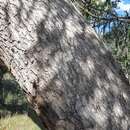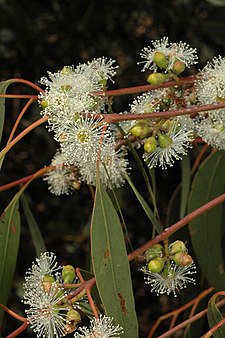pt-BR
nomes no trilho de navegação


Eucalyptus bridgesiana, commonly known as apple box, apple, apple gum[3] or but-but,[4] is a medium to large sized tree. It has rough, fibrous bark on the trunk and larger branches, smooth grey bark above, glossy green, lance-shaped adult leaves, flower buds in groups of seven, white flowers and hemispherical fruit.
Eucalyptus bridgesiana is a tree that typically grows to a height of 20 to 25 metres (66 to 82 ft) and forms a lignotuber. It has rough, fibrous, mottled grey and white, sometimes tessellated bark on the trunk and larger branches, with rough, grey, fibrous bark on its trunk and larger branches. Thinner branches have smooth grey bark with whitish patches, shed in short ribbons. Young plants and coppice regrowth have sessile, egg-shaped, heart-shaped or almost round leaves arranged in opposite pairs, 25–100 mm (0.98–3.9 in) long, 20–80 mm (0.8–3 in) wide, with wavy edges and covered with a powdery white bloom. The adult leaves are lance-shaped, the same glossy green on both sides, 120–200 mm (4.7–7.9 in) long and 15–25 mm (0.6–1 in) wide on a petiole 12–35 mm (0.47–1.4 in) long. The flower buds are arranged in groups of seven on a peduncle up to 15 mm (0.6 in) long, the individual buds on a pedicel 1–5 mm (0.04–0.2 in) long. The mature buds are oval, 5–8 mm (0.20–0.31 in) long and 3–5 mm (0.1–0.2 in) wide with a conical to beaked operculum. Flowering occurs from February to March and the flowers are white. The fruit is a woody, hemispherical capsule, 3–7 mm (0.12–0.28 in) long and 4–8 mm (0.16–0.31 in) wide with the three valves extending above the rim.[3][4][5][6]
Eucalyptus bridgesiana was first formally described in 1898 by Richard Thomas Baker and the description was published in Proceedings of the Linnean Society of New South Wales.[7][8] The specific epithet (bridgesiana) honours Frederick Bridges (1840-1904) for his "promoting the opplication of economic science to our indigenous vegetable products".[8][9]
Apple box grows in open woodland and forest and is widespread from near Stanthorpe in Queensland and south through the slopes and ranges of New South Wales and eastern Victoria.
The wood of apple box is softer than that of other eucalypts, and is considered poor for firewood or building timber. However, the honey produced by bees feeding on the small white flowers of the tree is of high quality.[10]
Eucalyptus bridgesiana, commonly known as apple box, apple, apple gum or but-but, is a medium to large sized tree. It has rough, fibrous bark on the trunk and larger branches, smooth grey bark above, glossy green, lance-shaped adult leaves, flower buds in groups of seven, white flowers and hemispherical fruit.
 flowers and buds
flowers and buds  fruit
fruit
Eucalyptus bridgesiana, appelé communément gommier de Bridges[1], est une espèce du genre Eucalyptus, famille des Myrtaceae.
Eucalyptus bridgesiana est un arbre qui peut atteindre entre 15 et 25 mètres de haut[1] et de 5 à 7 m de large[2]. L'écorce de la boîte est généralement rugueuse et dans les branches plus minces exposées, l'écorce est de couleur de crème et lisse. Les feuilles juvéniles sont distinctement glauques et de forme ovale[1]. Les feuilles adultes sont lancéolées, concolores vertes à vert-bleu, brillantes et pendantes[1]. Les fleurs blanches paraissent entre janvier et mars en Australie[3] et entre octobre et décembre dans l'hémisphère nord[1].
Eucalyptus bridgesiana est présent dans le sud-est de l'Australie, généralement dans les zones boisées herbeuses et près des cours d'eau autour des pentes inférieures de la Cordillère australienne[3].
En exploitation, il ne tolère pas vraiment les sols fortement calcaires et ses branches ont tendance à cassez facilement lors de fortes rafales de vent, ce qui exclut une plantation dans les régions où le vent est fréquemment violent. Au jardin, un sujet à recépé après une période de gel jusqu'à −11 °C[1].
Les espèces associées comprennent Eucalyptus pauciflora, Eucalyptus melliodora et Eucalyptus rubida.
Le bois est doux par rapport aux autres eucalyptus, et est considéré comme pauvre pour le bois de chauffage ou le bois de construction. Cependant, le miel produit par les abeilles se nourrissant des petites fleurs blanches de l'arbre est de haute qualité[3].
Eucalyptus bridgesiana est une espèce à croissance rapide qui est vraiment ornementale en isolée[1].
Eucalyptus bridgesiana, appelé communément gommier de Bridges, est une espèce du genre Eucalyptus, famille des Myrtaceae.
Äppeleukalyptus (Eucalyptus bridgesiana) är en art i familjen myrtenväxter. Arten kommer ursprungligen från östra Australien. I Sverige används arten som ettårig utplanteringsväxt.
Äppeleukalyptus (Eucalyptus bridgesiana) är en art i familjen myrtenväxter. Arten kommer ursprungligen från östra Australien. I Sverige används arten som ettårig utplanteringsväxt.
Eucalyptus bridgesiana là một loài thực vật có hoa trong Họ Đào kim nương. Loài này được F.Muell. ex R.T.Baker mô tả khoa học đầu tiên năm 1898.[1]
Eucalyptus bridgesiana là một loài thực vật có hoa trong Họ Đào kim nương. Loài này được F.Muell. ex R.T.Baker mô tả khoa học đầu tiên năm 1898.
Eucalyptus bridgesiana R.T.Baker
Эвкалипт Бриджеса (лат. Eucalyptus bridgesiana) — вечнозеленое дерево, вид рода Эвкалипт (Eucalyptus) семейства Миртовые (Myrtaceae).
В природе ареал вида охватывает западные склоны гор штата Новый Южный Уэльс, южную часть плоскогорья штата Квинсленд и северо-восточные склоны гор штата Виктория[2].
Растёт на низменностях, по склонам горных хребтов на известняках и сланцах.
На наносной, умеренно влажной почве за 16 лет достигает высоты в 26 м, при диаметре ствола 40 см. На склонах, особенно с глинистой почвой, рост намного слабее.
В густых насаждениях лесного типа растёт прямоствольно; на открытых местах и в одиночных посадках деревья искривляются и образуют раскидистые кроны.
Сравнительно морозостоек; без существенных повреждений выдерживает кратковременные морозы в -10… -9 °C, при более низкой температуре сильно страдает, однако степень повреждений деревьев при этом неодинаковая. Многие деревья легко переносят кратковременные морозы в -11 °C.
Дерево высотой более 30 м.
Кора беловато-серая, чешуевидная, морщинистая или сетчатая.
Молодые листья супротивные, в большом числе пар, сидячие или на черешках, округлые или яйцевидно-сердцевидные, тупые или заостренные, с волнистыми краями, ярко-сизые, длиной 2,5—7 см, шириной 2—4,5 см. Взрослые — очерёдные, на длинных черешках, ланцетные, часто серповидно изогнутые, тёмно-зеленые, длиной 15—30 см, шириной 2—4 см.
Зонтики пазушные, 5—7-цветковые, сидящие на цветоножках длиной 8—10 мм; бутоны на цветоножках, яйцевидные, заострённые, длиной 6—8 мм, диаметром 4—5 мм; крышечка полушаровидная, тупая или заострённая, равна полуяйцевидной трубке цветоложа или немного короче её; пыльники обратнояйцевидные, открываются параллельными щелями, железка яйцевидная, размещена на спинной стороне пыльника.
Плоды полушаровидные или кубарчатые, длиной 4—6 мм, диаметром 5—7 мм, на плодоножках, с утолщенным, слабо выпуклым диском и расходящимися, сильно выдвинутыми створками.
На Черноморском побережье Кавказа цветёт в июне — августе.
Древесина светлая, довольно твёрдая, непрочная, по другим источникам, древесина отличается хорошей прочностью и используется на столбы и даже шпалы. Используется как топливо.
Листья содержат эфирное (эвкалиптовое) масло (0,67 %), состоящее из цинеола (65%), пинена и сесквитерпена.
Пригоден для облесения неудобных земель с бедной почвой.
Вид Эвкалипт Бриджеса входит в род Эвкалипт (Eucalyptus) подсемейства Myrtoideae семейства Миртовые (Myrtaceae) порядка Миртоцветные (Myrtales).
Эвкалипт Бриджеса (лат. Eucalyptus bridgesiana) — вечнозеленое дерево, вид рода Эвкалипт (Eucalyptus) семейства Миртовые (Myrtaceae).